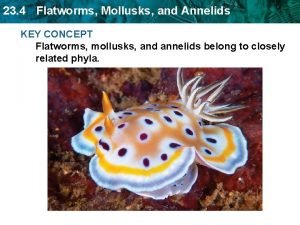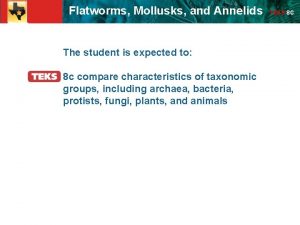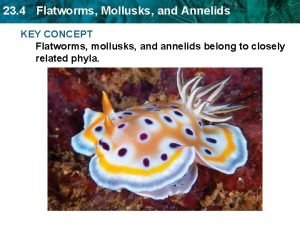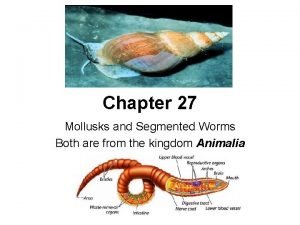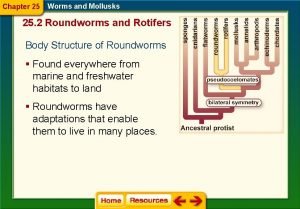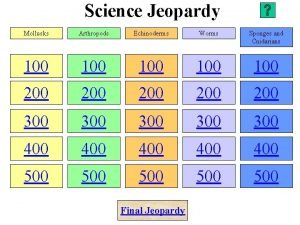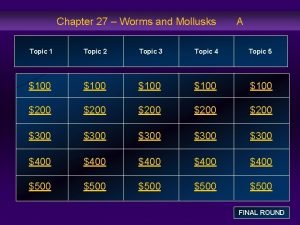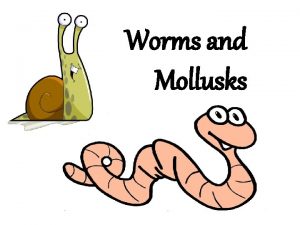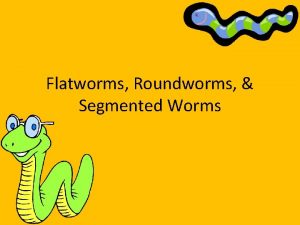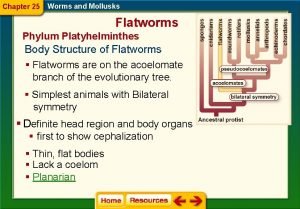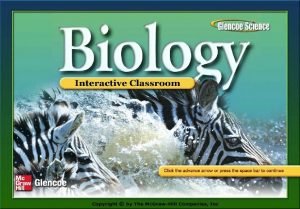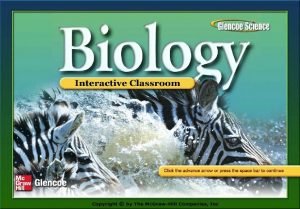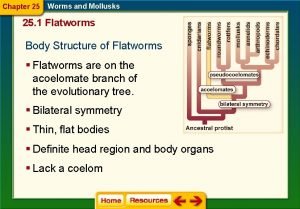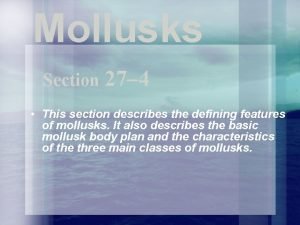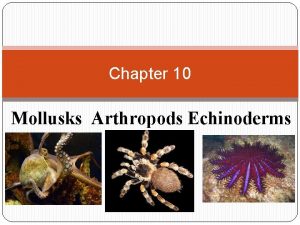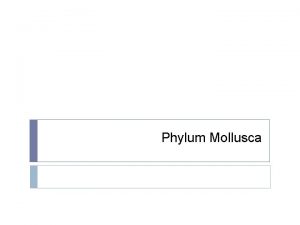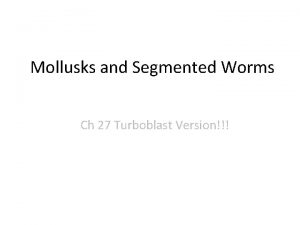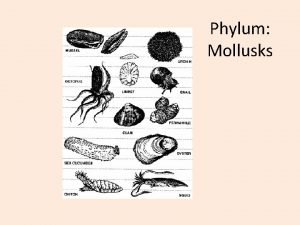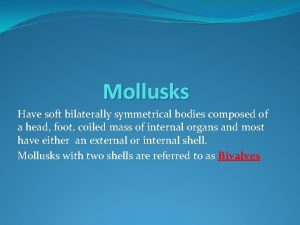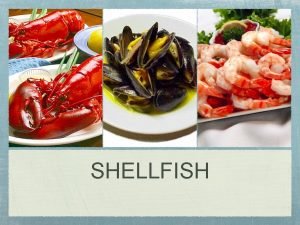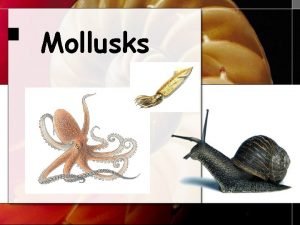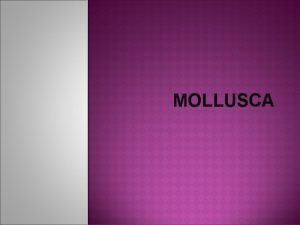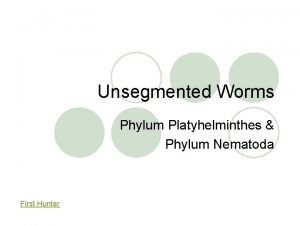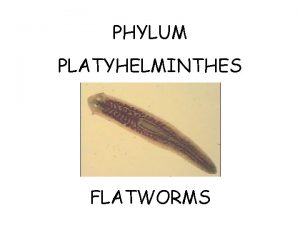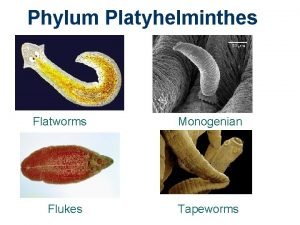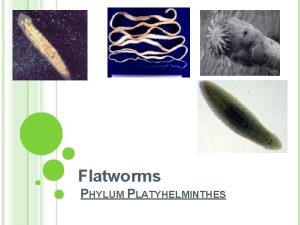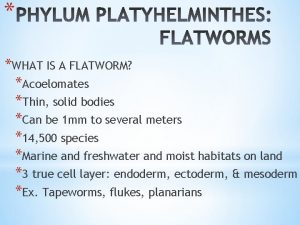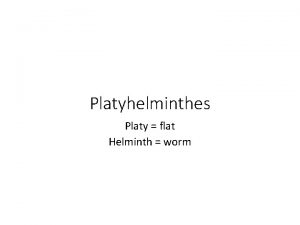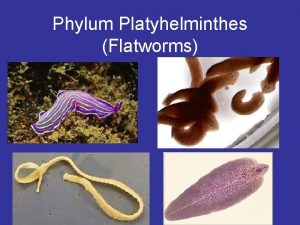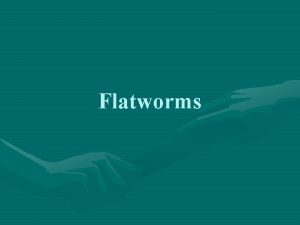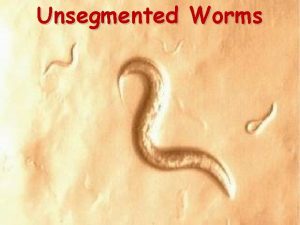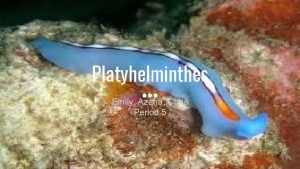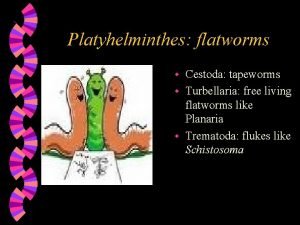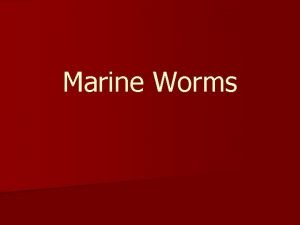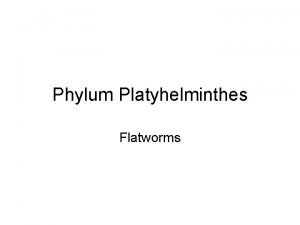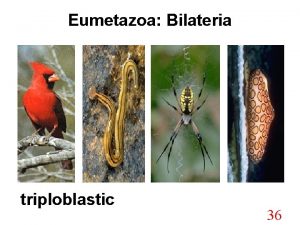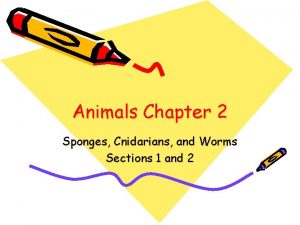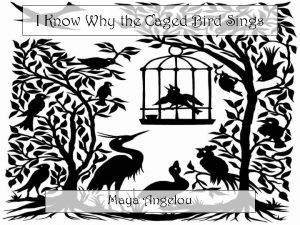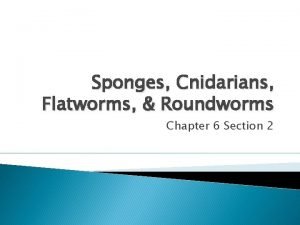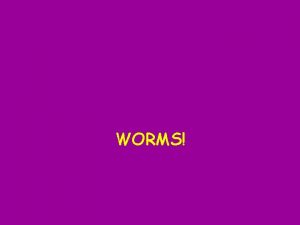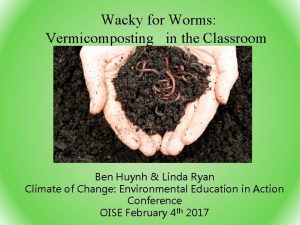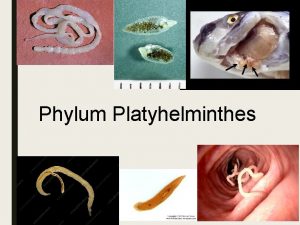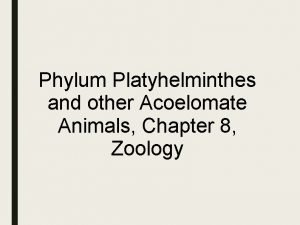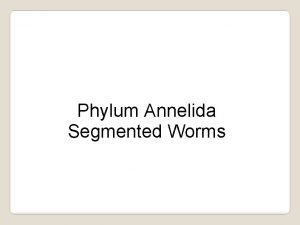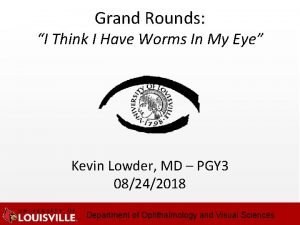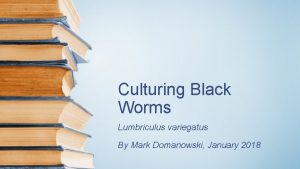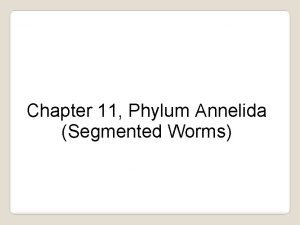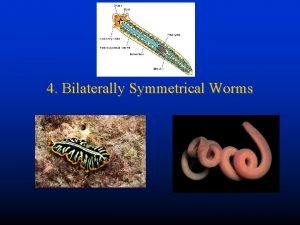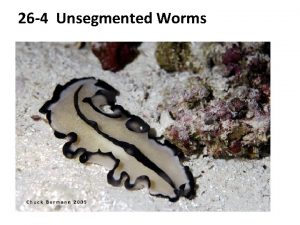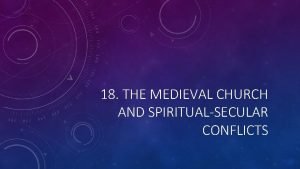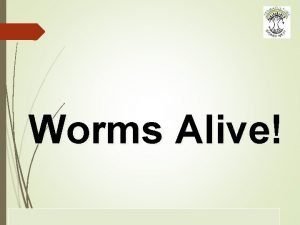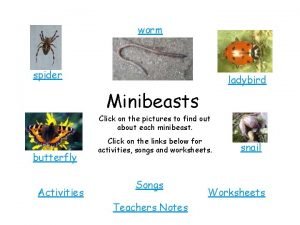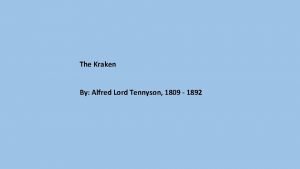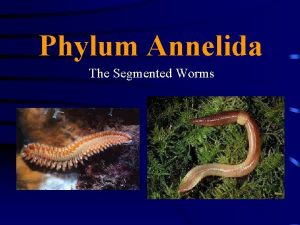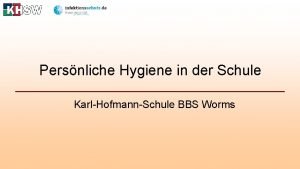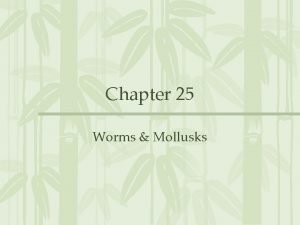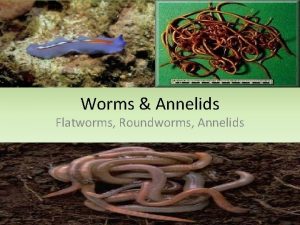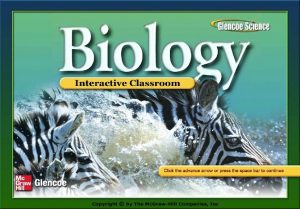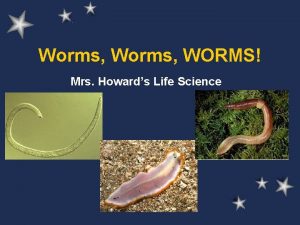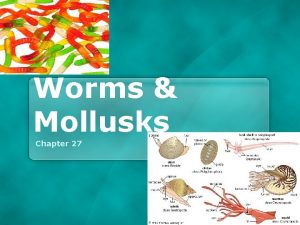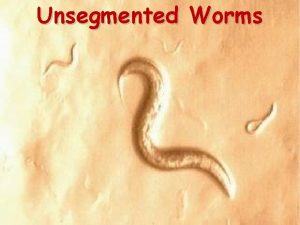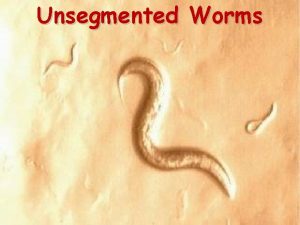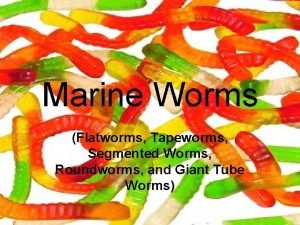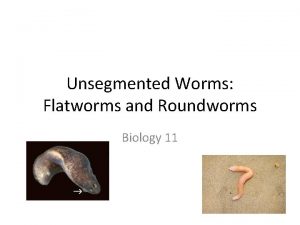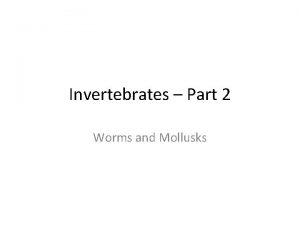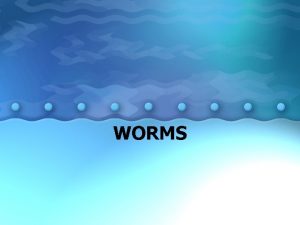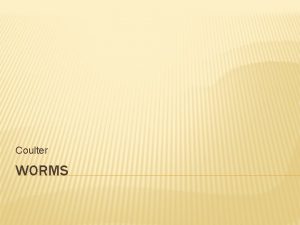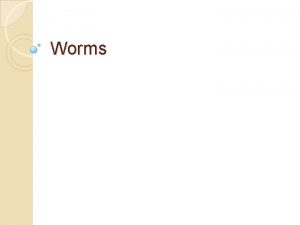Chapter 25 Worms and Mollusks Section 1 Flatworms































































- Slides: 63


Chapter 25 Worms and Mollusks Section 1: Flatworms Section 2: Roundworms and Rotifers Section 3: Mollusks Section 4: Segmented Worms Click on a lesson name to select.

Chapter 25 Worms and Mollusks Flatworms Phylum Platyhelminthes Body Structure of Flatworms § Flatworms are on the acoelomate branch of the evolutionary tree. § Simplest animals with Bilateral symmetry § Definite head region and body organs § first to show cephalization § Thin, flat bodies § Lack a coelom § Planarian

Chapter 25 Worms and Mollusks Flatworms Feeding and Digestion § Free-living flatworms feed on dead or slow-moving organisms. § Parasitic flatworms have modified feeding structures called hooks and suckers, which enable them to stay attached to their hosts. Pharynx

Chapter 25 Worms and Mollusks Flatworms Respiration, Circulation, and Excretion § Diffusion moves dissolved oxygen and nutrients to all parts of their bodies. § Carbon dioxide and other wastes also are removed from flatworm cells by diffusion.

Chapter 25 Worms and Mollusks Flatworms § Flame cells § move water out of the body to excrete waste products and maintain water balance § Primitive Kidney

Chapter 25 Worms and Mollusks Flatworms Response to Stimuli § The nervous system regulates the body’s response to stimuli.

Chapter 25 Worms and Mollusks Flatworms Movement § Move by contracting muscles in the body wall § Glide by using cilia located on their undersides

Chapter 25 Worms and Mollusks Flatworms Reproduction § Flatworms are hermaphrodites. § Two different flatworms exchange sperm, and the eggs are fertilized internally. § Flatworm Reproduction

Chapter 25 Worms and Mollusks Flatworms § Free-living flatworms can reproduce asexually by regeneration. § can only occur if part of the nerve cord is present

Chapter 25 Worms and Mollusks Flatworms Turbellarians § Live in marine or freshwater § Have eyespots that can detect the presence or absence of light § Sensory cells help them identify chemicals and water movement.


Chapter 25 Worms and Mollusks Flatworms Trematodes (Blood Flukes) § Parasites that infect the blood or body organs of their hosts § The parasitic fluke Schistosoma requires two hosts to complete its life cycle. § These fluke eggs clog blood vessels, causing swelling and eventual tissue damage.


Chapter 25 Worms and Mollusks Flatworms

Chapter 25 Worms and Mollusks 25. 1 Flatworms Cestodes (tapeworms) § Parasites adapted to life in the intestines of their hosts § Proglottids form continuously; as new ones form near the scolex, older proglottids move farther back and mature.


• Scolex – allows tapeworm to attach to the intestinal wall – Tapeworm movie clip

Chapter 25 Worms and Mollusks Roundworms Phylum Nematoda Body Structure of Roundworms § Found everywhere from marine and freshwater habitats to land § Roundworms have adaptations that enable them to live in many places. n Simplest animals to have a digestive system with 2 openings

Chapter 25 Worms and Mollusks Roundworms and Rotifers Feeding and Digestion § Most roundworms are free-living. § The movement of food through the digestive tract is one-way.

Chapter 25 Worms and Mollusks Roundworms and Rotifers Respiration, Circulation, Excretion, and Response to Stimuli § Most roundworms exchange gases and excrete metabolic wastes through their moist outer body coverings. § Ganglia and associated nerve cords coordinate nematode responses.

Chapter 25 Worms and Mollusks 25. 2 Roundworms and Rotifers Movement § Muscles cause their bodies to move in a thrashing manner as one muscle contracts and another relaxes. § These muscles pull against the outside body wall and the pseudocoelom.

Chapter 25 Worms and Mollusks Roundworms and Rotifers Reproduction § Roundworms reproduce sexually. § Fertilization is internal. § Larva hatch from the fertilized eggs.

Ascaris

Filarial worms

Hookworms

Trichinella

Pin Worms

Chapter 25 Worms and Mollusks 25. 2 Roundworms and Rotifers Nematodes in Plants § Nematodes can infect and kill pine trees, soybean crops, and food plants such as tomatoes.

Chapter 25 Worms and Mollusks 25. 2 Roundworms and Rotifers § Certain nematodes are used to control the spread of cabbage worm caterpillars, Japanese beetle grubs, and many other pests of crop plants. § Nematodes eat flea larvae, controlling the flea population in yards.

Chapter 25 Worms and Mollusks 25. 2 Roundworms and Rotifers PHYLUM Rotifera: Rotifers § Bilateral symmetry § Pseudocoelomates § Exchange gases and excrete metabolic wastes by diffusion through body walls. § Sensory structures include sensory bristles and eyespots on the head.

• Rotifer feeding

• Stop

Chapter 25 Worms and Mollusks Body Structure of Mollusks § Mollusks are coelomate animals with bilateral symmetry, a soft internal body, a digestive tract with two openings, a muscular foot, and a mantle.

Chapter 25 Worms and Mollusks

Chapter 25 Worms and Mollusks Feeding and Digestion § A radula scrapes food into their mouths.

Chapter 25 Worms and Mollusks § Mollusks have complete guts with digestive glands, stomachs, and intestines.

Chapter 25 Worms and Mollusks Respiration § Gills are parts of the mantle. § Gills contain a rich supply of blood for the transport of oxygen to the blood and for the removal of carbon dioxide from the blood.

Chapter 25 Worms and Mollusks Circulation § In an open circulatory system, blood is pumped out of vessels into open spaces surrounding the body organs. Occurs in slow moving mollusks such as snails, slugs § Oxygen and nutrients diffuse into tissues that are bathed in blood and carbon dioxide diffuses from tissues into the blood.

Chapter 25 Worms and Mollusks § In a closed circulatory system, blood is confined to vessels as it moves through the body. § A closed system efficiently transports oxygen and nutrients to cells where they are converted to usable forms of energy. § occurs in fast moving mollusks such as squid and octopus

Chapter 25 Worms and Mollusks Excretion § Mollusks get rid of metabolic wastes from cellular processes through structures called nephridia. Response to Stimuli § Nervous systems coordinate their movements and behavior.

Chapter 25 Worms and Mollusks Reproduction § Mollusks reproduce sexually. § All mollusks share similar developmental patterns. § produce a trochophore § free swimming


Chapter 25 Worms and Mollusks Diversity of Mollusks § Gastropods (stomach foot) § The largest class of mollusks. § Most species of gastropods have a single shell. § Abalones, snails, conches, periwinkles, limpets, cowries, whelks, and cones § Slugs and nudibranchs do not have shells. § Poison in a cone

Chapter 25 Worms and Mollusks Bivalves (two halves) § Bivalves are two-shelled mollusks. § Clams, mussels, oysters, and scallops § Use a muscular foot to burrow into wet sand § Giant Clam

Chapter 25 Worms and Mollusks Cephalopods (head foot) § Cephalopods are the head-footed mollusks. § Squid, octopus, chambered nautilus, and the cuttlefish § The foot of a cephalopod is divided into arms and tentacles with suckers (suckers can ‘taste’ what the organism touches. )


• Video • Vampire squid • Giant Pacific Octopus

Chapter 25 Worms and Mollusks Cephalopod Protection § Expel water to propel themselves away from threat § Hide § Shoot out an inky substance that forms a cloud (reduces predators sense of smell!) § Change color to blend in with their surroundings


Chapter 25 Worms and Mollusks Segmented Worms Phylum Annelida § Annelids undergo protostome development. § Include earthworms, marine worms, and parasitic leeches § Segmented and have a coelom

Chapter 25 Worms and Mollusks Segmented Worms § Rigidity in annelid segments creates a hydrostatic skeleton that muscles can push against. § Segmentation also permits segments to move independently of each other and enables a worm to survive damage. § Segments can be specialized.

Chapter 25 Worms and Mollusks Segmented Worms Feeding and Digestion § Running through all earthworm segments from the mouth to the anus is the digestive tract.

Chapter 25 Worms and Mollusks Segmented Worms Circulation § Most annelids have a closed circulatory system. § Dorsal blood vessel takes blood to the anterior end § Ventral blood vessel takes blood to the posterior end

Chapter 25 Worms and Mollusks Segmented Worms Respiration and Excretion § Earthworms take in oxygen and give off carbon dioxide through their moist skin. § Aquatic annelids have gills for the exchange of gases in the water. § Segmented worms have two nephridia in almost every segment. § Help with filtering the blood

Chapter 25 Worms and Mollusks Segmented Worms Response to Stimuli § The anterior segments are modified for sensing the environment. Movement § The earthworm contracts circular muscles running around each segment. § The fluid pressure causes the segment to get longer and thinner.

Chapter 25 Worms and Mollusks 25. 4 Segmented Worms § The earthworm contracts the longitudinal muscles that run the length of its body. § This causes the segment to shorten and return to its original shape, pulling its posterior end forward and resulting in movement.

Chapter 25 Worms and Mollusks Segmented Worms Reproduction § Reproduce both sexually and asexually § Sperm are passed between two worms near segments called the clitellum. Earthworm Dissection

• Divided into 3 classes – Polychaetes • many bristles Sea Mouse (side 3 36232) Sand Worm (side 4 16757)

– Oligochaetes • “few bristles” • Earthworms – helps to re-fertilize the soil – helps to aerate the soil Giant Earthworm (side 4 23677)

– Hirundinea • Leeches • external parasites • point of attachment – uses a muscular proboscis – razor sharp pair of jaws Proboscis (side 3 35804)

• salivary glands – secretes a substance that anesthetizes the area (wound) – secretes an anticoagulant • prevents blood from clotting

• can swallow as much as 10 times their weight in blood • leech
 Section 4 flatworms mollusks and annelids
Section 4 flatworms mollusks and annelids Section 4 flatworms mollusks and annelids
Section 4 flatworms mollusks and annelids Section 4 flatworms mollusks and annelids
Section 4 flatworms mollusks and annelids Are worms mollusks
Are worms mollusks Chapter 25 section 4 segmented worms
Chapter 25 section 4 segmented worms Chapter 27 mollusks and segmented worms answer key
Chapter 27 mollusks and segmented worms answer key Chapter 27 worms and mollusks
Chapter 27 worms and mollusks Chapter 27 worms and mollusks
Chapter 27 worms and mollusks Are worms mollusks
Are worms mollusks Flatworm roundworm and segmented worm
Flatworm roundworm and segmented worm Are worms mollusks
Are worms mollusks Chapter 25 section 3 mollusks
Chapter 25 section 3 mollusks Chapter 25 section 1 flatworms
Chapter 25 section 1 flatworms Chapter 25 section 1 flatworms
Chapter 25 section 1 flatworms This section describes
This section describes Echinoderms
Echinoderms How do mollusks reproduce
How do mollusks reproduce Segmentation in mollusca
Segmentation in mollusca 4 classes of mollusks
4 classes of mollusks Are mollusks symmetrical
Are mollusks symmetrical Market forms of shellfish
Market forms of shellfish Mollusks tongue
Mollusks tongue Mollusks life cycle
Mollusks life cycle Mollusca multicellular
Mollusca multicellular Small flat unsegmented worms _________
Small flat unsegmented worms _________ Flat worms asexual reproduction
Flat worms asexual reproduction 3 classes of platyhelminthes
3 classes of platyhelminthes Monogenian
Monogenian Characteristics of flatworms
Characteristics of flatworms Are flatworms acoelomates
Are flatworms acoelomates How do flatworms move
How do flatworms move Flatworm phylum name
Flatworm phylum name Flatworms bilateral symmetry
Flatworms bilateral symmetry Phylum annelida consists of unsegmented worms.
Phylum annelida consists of unsegmented worms. Platyhelminthes
Platyhelminthes Free living flatworms
Free living flatworms Segmented worms symmetry
Segmented worms symmetry Are platyhelminthes acoelomates
Are platyhelminthes acoelomates Eumetazoa
Eumetazoa Sponges cnidarians and worms
Sponges cnidarians and worms Caged bird poem metaphor
Caged bird poem metaphor Chapter 26 sponges and cnidarians answer key
Chapter 26 sponges and cnidarians answer key Trojan horses spyware and worms are all forms of
Trojan horses spyware and worms are all forms of Section quick check chapter 10 section 1 meiosis answer key
Section quick check chapter 10 section 1 meiosis answer key Unsegmented worms meaning
Unsegmented worms meaning Pile worms teeth
Pile worms teeth Manorialism def
Manorialism def Platyhelminthes
Platyhelminthes What are flame cells in platyhelminthes
What are flame cells in platyhelminthes Characteristics of segmented worms
Characteristics of segmented worms Worm's eye view examples
Worm's eye view examples Glasgow thang điểm
Glasgow thang điểm Worms
Worms California black worms
California black worms How do worms reproduce
How do worms reproduce Do worms reproduce sexually or asexually
Do worms reproduce sexually or asexually Symmetry of worms
Symmetry of worms Unsegmented worms
Unsegmented worms Concordat of worms
Concordat of worms Greg worms
Greg worms Worms facts
Worms facts The kraken poem
The kraken poem Characteristics of segmented worms
Characteristics of segmented worms Bbs worms
Bbs worms
